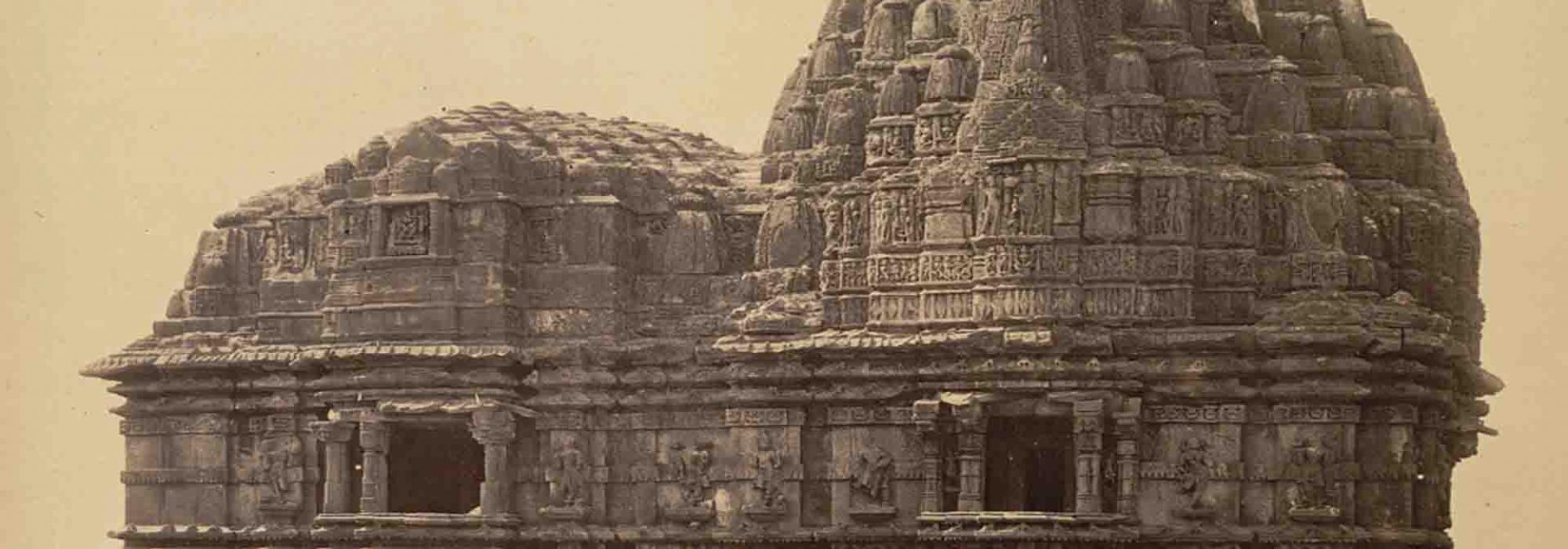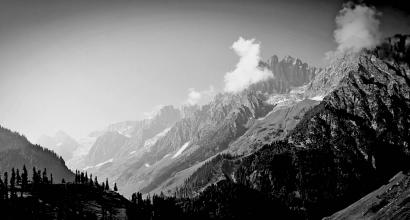K M Munshi writes in his preface to the fifth volume of the History and Culture of the Indian People,
“The year A.D. 1000 was a fateful year for India. In that year, Mahmūd of Ghaznī first invaded it. That event, in my opinion, divides Ancient from Medieval India… It was, however, disturbed on occasions, for instance, by the raids of Alexander; by the influx of the Bactrian Greeks, the Kushāṇas and the Śakas; by the invasion of the Hūṇas; by the Arab incursions in Sindh. But these inroads were only temporary episodes; the vitality of the culture and social organization found it easy to absorb most of the alien elements which were left behind in the country after they were closed.
“This continuous vitality is a phenomenon, without appreciating which it is difficult to study the epochs of Indian history in continuous time. Several factors have maintained it. Of them, perhaps the most important was the ‘Āryāvarta consciousness’ which threw up values and institutions of great vigour and tenacity.”
Speaking about the ill-effects of the barbarity of Islam, K M Munshi writes, “On Sabuktigin’s death, his son Mahmūd, with swift audacity, captured Ghaznī, which his father had left to another son. He was a military leader of the highest order, gifted with a rare personality. Developing a marvelous striking power, by A.D. 1000, he extended his sway over considerable parts of Central Asia, Iran and Seistan. Then he turned to India, giving her people a foretaste of total war with which they had not been familiar since the days of the Hūṇas.
“Mahmūd annexed the Punjab, thereby opening the way to the hungry men from the steppes of Central Asia to descend upon this rich and fertile land in search of plunder. Nothing would withstand the Central Asian raiders eager to plunder and destroy. In a few years, Thāneswar, Mathurā, Kanauj and Prabhāsa Pattana were smoking ruins. The ruler of Kanauj accepted submission on abject terms. The raids of the Turk were, however, halted in the east by Vidyādhara Chandella at Kālañjara and in the south-west, where after destroying the temple of Somanātha, Mahmūd had to beat a hasty retreat through the desert of Sindh for fear of the federated armies of ‘Paramadeva,’ whom I would identify with Bhoja Paramāra of Dhārā (A.D. 1000-1055).”[1]
As long as Bhoja was alive, Ghaznī could achieve little. But he had to face death on the battlefield because of several sanātanadharmis.
In spite of the repeated invasions and barbaric attacks of Ghazni Mahmud, those regions returned to normal in a short time. Within five years of Mahmud’s invasion during which he destroyed the Somanath temple, Gujarat became richer and more powerful than before. Not only did they rebuild the Somanath temple on a far more magnificent scale, they also constructed the Dilwara temple, a veritable artistic miracle.
Nationalism as familiar to the contemporary mind, is a non-religious group sentiment. It is associated with a fierce possessiveness over one's own land however vast it may be, entertained by a people who have willed themselves into a quasi-organic solidarity. Naturally, the Indian kings could not develop it, because the country was too vast and the times unfavourable to the development of a non-religious group sentiment of this nature. Five more centuries had to elapse before nationalism became a force in Europe and two hundred more years had to pass before it was to become a human value in Asia.[2]
Although the adherence to sanātana-dharma was strong, our people didn’t realize that it was important from them to unite politically. Since our land had been fragmented into tiny little kingdoms and provinces, the greatest tragedy that ensued was that no king could afford to step out of his kingdom even for a short while without the fear of his throne being usurped by his own people out of avarice for power. If a king went to a faraway place in order to battle with his enemies, there was always the possibility that his neighbours might swallow his kingdom; and therefore a situation arose where the king would broker peace with the enemy who was afar and spend his time managing his neighbours effectively.
This is a natural result of not having a large kingdom. Luminaries such as Bhagavān Kṛṣṇa, Kauṭilya, and Vidyāraṇya had observed this. That is the reason they didn’t give much importance to the system of republics. The system of independent republics was ineffective in countering the invasion of raiders such as Alexander. Further, the personal feelings of superiority and arrogance of individual kings became an obstacle for the larger war against the enemies.
For instance, we see in the Tarikh ul Hind of Al Biruni, Ghazni Mahmud’s court scholar, how the king of Punjab Anandapala writes a letter to Mahmud saying,
“I have heard that the Turks have invaded your dominions, and have spread over Khurasan; if you desire it, I will join you with 5,000 Cavalry, 10,000 Infantry, and 100 Elephants; but if you prefer it, I will send my son with twice the number. In making this proposal, I do not wish to ingratiate myself with you. Though I have vanquished you, I do not desire that anyone else but myself should obtain the ascendancy.”[3]
How does one describe this sort of madness? We learn from this that Anandapala had defeated Ghazni Mahmud earlier; but it also serves as a painful reminder that Hindu kings of India did not realize the depth and expanse of the cruelty and deceit of Islam.
Social stagnation, personal arrogance, and regional consciousness came together to pave way for petty-mindedness; this further paved way for political disintegration.
Historians have examined and written at length about this social lethargy. When the Islamic invasions took place, the behaviour of the Muslims was extremely horrifying and barbaric. Our people did not see Islam for the horror it was; they didn’t examine Islamic practices and try to understand its problems and faults. Instead, they kept the Muslims out of their own social realm. Social apathy (or boycott) is harmful. What is required is strong political decisiveness. This ended up becoming a simple social ostracization. We did not learn about the problems and faults inherent in other religions.
By c. 1000 CE, Mahmud Ghazni attacked Somanath via Sind. For about three hundred years after that Islam was trying to establish itself in India. In 1175 CE, Muhammad Ghori invaded India. There were three kings who were powerful enough to face him singly – the first was the king of Ajmer who had made Delhi his capital, Prithviraj Chahamana (Chauhan); the second was Jayantachandra (or Jayachandra) Gahadavala of Kanyakubja (Kannauj); and the third was Mularaja II of the Chalukya dynasty of Gujarat. Each had the strength to drive Muhammad Ghori away. But they never tried to unite their forces and wage war against him.
Mularaja II drove him back in 1178 and Prithviraj in 1191. And in the second Battle of Tarain in 1192, the brave Prithviraj himself lost. The main reason for the defeat was not Ghori’s valour but his deception coupled with Prithviraj’s misplaced chivalry. A K Warder writes about this in his multi-volume work, “Indian Kāvya Literature” while writing about the Mudrārākṣasa:
“As long as India could produce Cāṇakyas [and his policy of śaṭham prati śāṭhyam], her civilisation flourished, defended from the aggression of the mlecchas. When on the other hand she relied on simple, straight-forward heroism and chivalry, as the ideal, her civilisation was gradually destroyed by barbarous invaders.”[4]
Jayachandra and Prithviraj were rivals. King Samarasimha of the Sisodia dynasty of Mewar was a dear friend of Jayachandra. Karmadevi, who was Jayachandra’s sister, was married to Samarasimha. In the first Battle of Tarain, Samarasimha and Prithviraj jostled with each other. But in the second Battle of Tarain, Muhammad Ghori used trickery. In response to his letter that said, “I have to first consult with my brother” (before withdrawing my forces), Prithviraj stupidly loosened his reins, trusting the invader. This was a huge blunder.
In the Mahābhārata, before the killing of Duryodhana, Śrīkṛṣṇa counsels Yudhiṣṭhira: one has to defeat an enemy who is full of deceit and trickery using the same method: māyāvinaṃ ca rājānaṃ māyayaiva nikṛntatu (Śalyaparva 57.7) and māyāvī māyayā vadhyaḥ satyametadyudhiṣṭhira (Śalyaparva 30.6)
When Duryodhana, who was hiding in the Vaiśampāyana Lake, steps out of it, Yudhiṣṭhira tells him that he can choose any weapon he likes and battle any one of the five Pāṇḍavas. In response, Kṛṣṇa chides him that just like how he foolishly played dice in the past, now he’s doing the same thing by trying to play a game of dice on the battlefield. tadidaṃ dyūtamārabdhaṃ punareva yathā purā (Śalyaparva 32.7).
This sort of pseudo-intelligence of Dharmarāja destroyed the country itself; it is the awareness of reality inherent in Kṛṣṇa and Bhīma that will bode well for our land, keeping it safe.
Translated by Hari Ravikumar and Sandeep Balakrishna
Notes
[1] History and Culture of the Indian People. Volume 5 – The Struggle for Empire. Ed. Majumdar, R. C. Bombay: Bharatiya Vidya Bhavan, 1967. pp. vii–xii.
[2] Ibid p. xiii.
[3] Elliot, H M and Dowson, John. The History of India as Told by its own Historians. Volume 2. London: Trübner and Co., 1869. pp. 12-13.
[4] Warder, A. K. Indian Kāvya Literature. Volume 3. New Delhi: Motilal Banarsidass, 1977. p. 277.





































